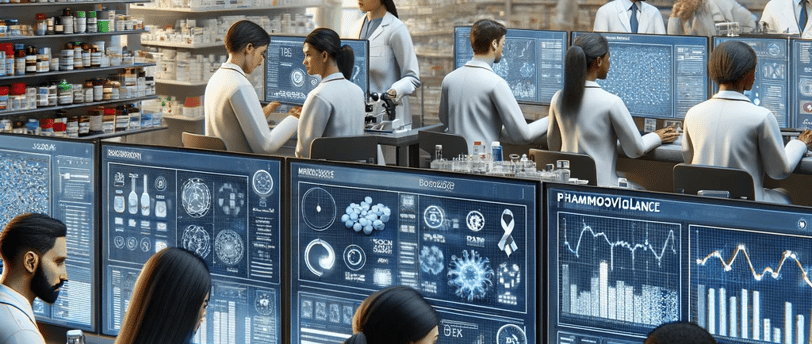Pharmacovigilance: Understanding the steps of monitoring pharmaceutics


Pharmacovigilance, a term derived from the Greek words "pharmakon" meaning drug and "vigilare" meaning to watch, refers to the science and activities related to the detection, assessment, understanding, and prevention of adverse effects or any other drug-related problems. It plays a crucial role in ensuring the safety and efficacy of medications used by millions of people worldwide.
What is Pharmacovigilance?
Pharmacovigilance encompasses a range of activities that aim to monitor and evaluate the safety profile of drugs throughout their lifecycle. It involves the systematic collection, analysis, and interpretation of data related to adverse drug reactions (ADRs) and other drug-related problems. Pharmacovigilance is not limited to just prescription drugs but also includes over-the-counter medications, vaccines, herbal products, and medical devices.
The primary objective of pharmacovigilance is to identify previously unknown or rare adverse effects that may occur when a drug is used in a larger population. It helps in detecting any potential risks associated with the use of medications and provides valuable information to healthcare professionals, regulatory authorities, and pharmaceutical companies to make informed decisions regarding drug safety.
Why is Pharmacovigilance Important?
Pharmacovigilance plays a critical role in safeguarding public health by identifying and minimizing the risks associated with the use of medications. Here are some key reasons why pharmacovigilance is of utmost importance:
1. Patient Safety:
Ensuring patient safety is the primary goal of pharmacovigilance. By monitoring and collecting data on adverse drug reactions, pharmacovigilance helps in identifying potential risks and taking appropriate measures to protect patients from harm.
2. Early Detection of Adverse Effects:
Pharmacovigilance activities enable the early detection of adverse effects that may not have been identified during clinical trials due to the limited number of participants or the short duration of the study. Timely identification of these adverse effects helps in preventing further harm to patients and facilitates the development of safer treatment options.
3. Improving Drug Regulatory Decisions:
Pharmacovigilance data provides valuable insights into the safety profile of drugs, which aids regulatory authorities in making informed decisions regarding drug approvals, labeling changes, and post-marketing surveillance. It helps in ensuring that only safe and effective medications are available in the market.
4. Enhancing Drug Development:
Pharmacovigilance data contributes to the ongoing evaluation of drugs, even after they have been approved and marketed. By identifying potential safety concerns, pharmacovigilance helps in improving the overall drug development process and promotes the development of safer and more effective medications.
How is Pharmacovigilance Implemented?
The implementation of pharmacovigilance involves various stakeholders, including healthcare professionals, regulatory authorities, pharmaceutical companies, and patients. Here are the key steps involved in pharmacovigilance:
1. Reporting of Adverse Drug Reactions:
Healthcare professionals, patients, and caregivers play a crucial role in reporting any suspected adverse drug reactions. They can report these reactions to the national pharmacovigilance center or the pharmaceutical company responsible for the drug. Timely and accurate reporting is essential for effective pharmacovigilance.
2. Data Collection and Analysis:
The reported adverse drug reactions are collected, analyzed, and evaluated by pharmacovigilance experts. This includes assessing the severity, causality, and frequency of the reported reactions. The data is then recorded in pharmacovigilance databases for further analysis.
3. Signal Detection:
Signal detection involves the systematic analysis of pharmacovigilance data to identify any potential safety concerns or patterns of adverse drug reactions. Various statistical and analytical methods are employed to detect signals that may indicate a previously unknown or rare adverse effect.
4. Risk Assessment and Management:
Once a signal is detected, a thorough risk assessment is conducted to evaluate the potential risks associated with the drug. This assessment helps in determining the appropriate risk management strategies, such as updating product labeling, issuing safety alerts, or even withdrawal of the drug from the market if necessary.
5. Communication and Collaboration:
Effective communication and collaboration between healthcare professionals, regulatory authorities, and pharmaceutical companies are vital in pharmacovigilance. The sharing of information and insights helps in enhancing drug safety and ensuring the prompt implementation of necessary actions to protect public health.
6. Continuous Monitoring and Evaluation:
Pharmacovigilance is an ongoing process that involves continuous monitoring and evaluation of drug safety. The collected data is regularly reviewed, and new safety information is communicated to healthcare professionals and the public to ensure the safe use of medications.
Conclusion
Pharmacovigilance serves as a cornerstone in ensuring the safety and efficacy of medications. By actively monitoring and evaluating the safety profile of drugs, pharmacovigilance plays a vital role in protecting patients from potential harm. The collaborative efforts of healthcare professionals, regulatory authorities, and pharmaceutical companies are essential in implementing effective pharmacovigilance measures. Through continuous vigilance and analysis of pharmacovigilance data, we can enhance drug safety, improve patient outcomes, and promote public health.

